Free Facts For Choosing Bamboo Clothing
Wiki Article
What Are The Benefits Of Base Layers Made Of Yak Merino For Winter Sports Clothing?
Natural fibers are a great option for base layers of winter sports apparel, and not only for their performance but also for their sustainability.
Both Merino and Yak are organic fibers that are derived from animals. They are renewable resources that can be harvested sustainably and without harming animals. They are biodegradable, which means they are able to can be broken down in nature without causing environmental harm.
Low Environmental Impact
Natural fibers tend to have a lower environmental impact than synthetic fibers. The harvesting and cultivation of wool is less involving chemicals and less non-renewable substances as compared to synthetic fibers.
Energy Efficiency
Wool fibers consume less energy to process than synthetic fibers such as nylon or polyester. The manufacturing process for natural wool requires less energy, which lowers carbon emissions.
Minimizing Microplastic Pollution
Wool fibers have less impact on microplastics in water bodies than synthetic fibers. Synthetic fibers remove microplastics while being washed.
Durability and Recycling
Yak merino clothing can last many years, and are incredibly durable. Wool fibers can also be reused or recycled, which reduces the amount of waste.
Sustainable Practices
Wool producers and manufactures adhere to ethical, sustainable practices. These include animal welfare, land management responsible and fair treatment for workers in the production chain.
Environmental Certification-
Insuring consumers about the sustainable production of wool is a way to demonstrate this through a certification like the Responsible Textile Standard (GOTS) or the Global Organic Textile Standard.
Overall, yak merino wool base layers are in line with the environment by coming from natural, renewable sources that have the least environmental impact in production and often using ethical and sustainable practices into the supply chain. Selecting natural fibers such as yak merino wool for winter sportswear is a step towards environmentally friendly and responsible consumption practices. View the top merino wool base layers examples for more info including wool mid layer, smartwool merino 250, best wool base layer, ski thermals, merino wool base layer pant, smartwool 1 4 zip, merino wool underwear womens, wool long underwear women's, smartwool base layer, ski layers womens and more.

What Are The Benefits Of Bamboo Clothing In Terms Of Softness And Antibacterial Properties As Well As Durability And Renewable?
Bamboo clothing is soft and durable. It is renewable, long-lasting, and antibacterial.
Bamboo fabric has a luxurious and silky feel, which is often likened to other luxurious fabrics, such as silk or cashmere. It feels gentle and smooth against your skin, providing a comfortable and pleasant wearing experience.
Antibacterial Properties
Bamboo possesses natural antimicrobial properties. Bamboo contains "bamboo-kun," an naturally present antimicrobial substance. This property helps to inhibit the growth of bacteria that cause odor as well as fungi and mold that can be found on the bamboo.
Durability-
Strength- Bamboo fibres, although soft, are strong and durable. Clothing made of bamboo is impervious to tearing and wear. This makes it suitable for various kinds of activities.
Renewability-
Rapid Growth Bamboo is a sustainable resource and grows rapidly, without needing pesticides. Bamboo harvest can take a short period of time, and can reduce the environmental impact.
Sustainability-
Sustainable Production- Bamboo cultivation and processing typically are less harmful to the environment compared to the production of synthetic materials. Bamboo is sustainable because of its rapid growth, the fact that it requires little water, and because it can be grown in a variety of climates.
Biodegradability-
Natural Decomposition- Bamboo clothing can naturally decompose when it is time to end its lifespan. This feature reduces waste that is not biodegradable in landfills. It also minimizes the impact of pollution.
Hypoallergenic Qualities
More Comfortable Bamboo isn't as prone to cause irritation on the skin or allergic reactions compared to some synthetic materials, which makes it an ideal choice for people with sensitive skin.
Bamboo clothing offers a combination of antibacterial and softness with durability, renewability and sustainability. It is an attractive choice for people who are looking for comfortable, functional and eco-friendly clothes. These characteristics provide a satisfying experience while wearing and are in line with eco-conscious practices. See the top rated bamboo clothings blog for website recommendations including bamboo workout clothes, bamboo yoga pants, bamboo newborn clothes, bamboo sun hoody, mens boxer shorts bamboo, bamboo cotton t shirts, bamboo exercise clothing, bamboo cay shirts, bamboo leggings, bamboo fibre clothing and more.

How Do Bamboo And Merino Clothing Compare With Regular Wool?
Merino wool layers, bamboo clothing and regular wool all have distinct features that distinguish them from other wools. Merino Wool-
Softness Merino wool is known for its soft and fine fibers. This makes it soft against the skin. It's less likely to trigger irritation or itching compared to traditional wool.
Merino Wool is Moisture Wicking. Merino wool wicks moisture from the skin and allows it evaporate, keeping the wearer comfortable and dry.
Merino Wool is a great insulation and offers warmth even when it is wet. It regulates body temperature as it provides insulation and airflow for overheating when exercising.
Odor Resistance- It naturally blocks the growth of bacteria that cause odor, keeping garments fresh even when worn for a long time.
Bamboo Clothing
The silky texture is often compared to cashmere or silk. It's luxurious and soft to wear.
Bamboo fabric has moisture-wicking properties that draw out moisture and help keep you dry.
Temperature Regulation- Bamboo clothing has natural temperature-regulating abilities, offering warmth in winter and breathability to prevent overheating.
Sustainability Bamboo is a source which is renewable and can grow very quickly, without the use of pesticides. It's biodegradable with a low environmental impact.
Wool Regular
Texture. Wool is traditionally available in a range of textures. Some are rougher, and can cause irritation or itchiness.
Wool is an excellent insulation material. It can be extremely warm, however it might appear too heavy or large.
Wool is less effective than bamboo or merino fabric in wicking moisture away because it is able to absorb moisture. But, it keeps warmth even when it is damp.
In the end, merino Wool offers softness, excellent moisture-wicking, odor resistance, and insulation. Bamboo clothing is a luxurious and breathable feeling. Also, it regulates temperature and is eco-friendly. Regular wool comes in a variety of textures but may not have the same softness and moisture wicking properties as merino or bamboo clothing, but can provide warmth and insulation. Each material can be tailored to specific preferences, and has distinct advantages. Follow the top rated these details for merino winter clothings for more info including merino wool long johns, merino wool first lite, womens icebreaker base layer, smartwool base layer mens, best merino wool base layer women's, wool undershirt women's, merino wool first lite, merino wool underwear womens, ski base layer pants, smartwool long johns and more.
